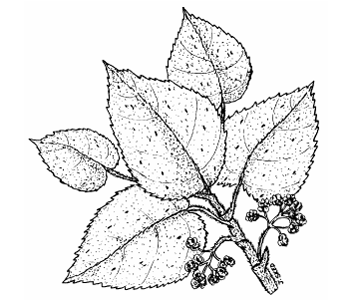
Plants that Bite
| |
 |
| |
Dendrocnide excelsa
Drawing: Jan Sked |
With its great beauty, diversity and density of life, sub-tropical rainforest is capable of inspiring feelings of peace and tranquillity. It can also produce very different feelings, those of pain and discomfort, if you are unfortunate enough to come into contact with some of its inhabitants. Among the most infamous are the aptly named Giant Stinging Trees (Dendrocnide excelsa) and Wait-a-While (Calamus muelleri). I'm sure that more than once they have been referred to as being 'good for nothing' and 'a waste of space' by bushwalkers inconvenienced by a chance meeting. But in fact, nothing could be further from the truth.
Australian Aborigines have lived successfully in Australia for tens of thousands of years by being incredibly resourceful and making use of the plants available around them for food, medicine, shelter and tools. The Giant Stinging Tree and Wait-a-While are no exception, with many uses.
Giant Stinging Tree
The defining characteristic of this tall rainforest tree is the large heart-shaped leaves covered with stinging hairs that cause severe pain to humans. These leaves were applied to the skin to relieve the symptoms of rheumatism via a process called urtification. Urtification is the practice of deliberately stinging the skin with nettles, tricking the nervous system into overlooking the deeper pain of arthritis and rheumatism. The white-to-pink clusters of juicy fruit stalks were eaten, in spite of the fact that they are also scattered with stinging hairs. The inner part of the creamy grey bark is very fibrous and was used in the construction of fishing lines and nets and was also chewed to create a mop-like tool that was used for extracting honey from native bee nests. When green, this inner layer of bark was beaten out to make cloth for baby's blankets.
Wait-a-While
This slender cane-like climbing palm is armed with hooked spines on its leaves, stems and tendrils. These spines aid its climb towards the canopy, but also excel at catching clothing and flesh of passers by. Aborigines exploited this feature by using the tendrils and stems as fish hooks in north Queensland and as a means of extracting witchetty grubs from their holes. The plant itself was a food source. The outer fleshy layer of the scaly, creamy-yellow coloured round berries was eaten, and was also squashed into water to make an acid drink.
The wait-a-while also had medicinal applications. Aborigines drank the sap to provide relief from cold and flu symptoms, and chewed and swallowed young tips to combat dysentery. The cane and leaves were used to make baskets and huts. Vine stems were used to make fish net frames and waist straps for support while climbing trees in search of food.
While bushwalkers might consider these plants as, quite literally, a pain in the neck (or where ever else gets hit!), there is obviously much more to these plants, as Australian Aborigines found practical applications for almost every part of them.
References: Symons & Symons (1994). Bush Heritage, Pat & Sim Symons
Bernard Hicks, Ranger, Brisbane Forest Park.
Source: Bush Telegraph, published by Queensland Parks and Wildlife Service, Environmental Protection Agency.
From the newsletter of the Caboolture Daytime Branch of the Society for Growing Australian Plants (Queensland), June 2005 via the newsletter of the Pine Rivers Branch, May 2008.
Australian Plants online - 2008
Association of Societies for Growing Australian Plants
|